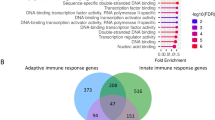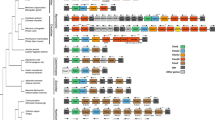Abstract
Defensins are members of a large diverse family of cationic antimicrobial peptides that share a signature pattern consisting of six conserved cysteine residues. Defensins have a wide variety of functions and their disruption has been implicated in various human diseases. Here we report the characterization of DEFB119–DEFB123, five genes in the human β-defensin cluster locus on chromosome 20q11.1. The genomic structures of DEFB121 and DEFB122 were determined in silico. Sequences of the five macaque orthologs were obtained and expression patterns of the genes were analyzed in humans and macaque by semiquantitative reverse transcription polymerase chain reaction. Expression was restricted to the male reproductive tract. The genes in this cluster are differentially regulated by androgens. Evolutionary analyses suggest that this cluster originated by a series of duplication events and by positive selection. The evolutionary forces driving the proliferation and diversification of these defensins may be related to reproductive specialization and/or the host–parasite coevolutionary process.
This is a preview of subscription content, access via your institution
Access options
Subscribe to this journal
Receive 6 digital issues and online access to articles
$119.00 per year
only $19.83 per issue
Buy this article
- Purchase on Springer Link
- Instant access to full article PDF
Prices may be subject to local taxes which are calculated during checkout








Similar content being viewed by others


References
Ganz T . Defensins: antimicrobial peptides of innate immunity. Nat Rev Immunol 2003; 3: 710–720.
Schutte BC, Mitros JP, Bartlett JA et al. Discovery of five conserved beta-defensin gene clusters using a computational search strategy. Proc Natl Acad Sci USA 2002; 99: 2129–2133.
Rodriguez-Jimenez F-J, Krause A, Schulz S et al. Distribution of new human [beta]-defensin genes clustered on chromosome 20 in functionally different segments of epididymis. Genomics 2003; 81: 175–183.
Semple C, Rolfe M, Dorin J . Duplication and selection in the evolution of primate beta-defensin genes. Genome Biol 2003; 4: R31.
Yang D, Biragyn A, Hoover DM, Lubkowski J, Oppenheim JJ . Multiple roles of antimicrobial defensins, cathelicidins, and eosinophil-derived neurotoxin in host defense. Annu Rev Immunol 2004; 22: 181–215.
Goldman MJ, Anderson GM, Stolzenberg ED, Kari UP, Zasloff M, Wilson JM . Human beta-defensin-1 is a salt-sensitive antibiotic in lung that is inactivated in cystic fibrosis. Cell 1997; 88: 553–560.
Schroder JM, Harder J . Human beta-defensin-2. Int J Biochem Cell Biol 1999; 31: 645–651.
Lehrer RI . Primate defensins. Nat Rev Microbiol 2004; 2: 727–738.
Garcia JR, Jaumann F, Schulz S et al. Identification of a novel, multifunctional beta-defensin (human beta-defensin 3) with specific antimicrobial activity. Its interaction with plasma membranes of Xenopus oocytes and the induction of macrophage chemoattraction. Cell Tissue Res 2001; 306: 257–264.
Yang D, Chertov O, Bykovskaia SN et al. Defensins: linking innate and adaptive immunity through dendritic and T cell CCR6. Science 1999; 286: 525–528.
Yamaguchi Y, Nagase T, Makita R et al. Identification of multiple novel epididymis-specific {beta}-defensin isoforms in humans and mice. J Immunol 2002; 169: 2516–2523.
Avellar MCW, Honda L, Hamil KG et al. Differential expression and antibacterial activity of epididymis protein 2 isoforms in the male reproductive tract of human and rhesus monkey (Macaca mulatta). Biol Reprod 2004; 71: 1453–1460.
Yudin AI, Tollner TL, Li MW, Treece CA, Overstreet JW, Cherr GN . ESP13.2, a member of the beta-defensin family, is a macaque sperm surface-coating protein involved in the capacitation process. Biol Reprod 2003; 69: 1118–1128.
Zhou CX, Zhang YL, Xiao L et al. An epididymis-specific beta-defensin is important for the initiation of sperm maturation. Nat Cell Biol 2004; 6: 458–464.
Rodriguez C, Kirby J, Hinton B . Regulation of gene transcription in the epididymis. Reproduction 2001; 122: 41–48.
Orgebin-Crist MC . Androgens and epididymal function. In: Bhasin SGH, Spieler JM, Swerdloff RE, Wang C, Kelly C (eds). Pharmacology, Biology, and Clinical Applications of Androgens. Wiley-Liss: New York, 1996, pp 27–38.
Hinton BT, Lan ZJ, Rudolph DB, Labus JC, Lye RJ . Testicular regulation of epididymal gene expression. J Reprod Fertil Suppl 1998; 53: 47–57.
Gould KG, Young LG . Acquisition of fertilizing capacity by chimpanzee sperm. Folia Primatol (Basel) 1990; 54: 105–108.
Morrison GM, Semple CA, Kilanowski FM, Hill RE, Dorin JR . Signal sequence conservation and mature peptide divergence within subgroups of the murine beta-defensin gene family. Mol Biol Evol 2003; 20: 460–470.
Swanson WJ, Vacquier VD . The rapid evolution of reproductive proteins. Nat Rev Genet 2002; 3: 137–144.
Hughes AL, Yeager M . Coordinated amino acid changes in the evolution of mammalian defensins. J Mol Evol 1997; 44: 675–682.
Boniotto M, Tossi A, DelPero M et al. Evolution of the beta defensin 2 gene in primates. Genes Immun 2003; 4: 251–257.
Maxwell AI, Morrison GM, Dorin JR . Rapid sequence divergence in mammalian beta-defensins by adaptive evolution. Mol Immunol 2003; 40: 413–421.
Swanson WJ, Nielsen R, Yang Q . Pervasive adaptive evolution in mammalian fertilization proteins. Mol Biol Evol 2003; 20: 18–20.
Liu Q, Hamil KG, Sivashanmugam P et al. Primate epididymis-specific proteins: characterization of ESC42, a novel protein containing a trefoil-like motif in monkey and human. Endocrinology 2001; 142: 4529–4539.
Yenugu S, Hamil KG, Radhakrishnan Y, French FS, Hall SH . The androgen-regulated epididymal sperm-binding protein, human beta-defensin 118 (DEFB118) (formerly ESC42), is an antimicrobial beta-defensin. Endocrinology 2004; 145: 3165–3173.
Saitou N, Nei M . The neighbor-joining method: a new method for reconstructing phylogenetic trees. Mol Biol Evol 1987; 4: 406–425.
Kumar S, Hedges SB . A molecular timescale for vertebrate evolution. Nature 1998; 392: 917–920.
Hwang PM, Vogel HJ . Structure–function relationships of antimicrobial peptides. Biochem Cell Biol 1998; 76: 235–246.
White SH, Wimley WC, Selsted ME . Structure, function, and membrane integration of defensins. Curr Opin Struct Biol 1995; 5: 521–527.
Li P, Chan HC, He B et al. An antimicrobial peptide gene found in the male reproductive system of rats. Science 2001; 291: 1783–1785.
Murphy CJ, Foster BA, Mannis MJ, Selsted ME, Reid TW . Defensins are mitogenic for epithelial cells and fibroblasts. J Cell Physiol 1993; 155: 408–413.
Ezer N, Robaire B . Gene expression is differentially regulated in the epididymis after orchidectomy. Endocrinology 2003; 144: 975–988.
Zhang J, Dyer KD, Rosenberg HF . Evolution of the rodent eosinophil-associated RNase gene family by rapid gene sorting and positive selection. Proc Natl Acad Sci USA 2000; 97: 4701–4706.
Nei M, Gu X, Sitnikova T . Evolution by the birth-and-death process in multigene families of the vertebrate immune system. Proc Natl Acad Sci USA 1997; 94: 7799–7806.
Del Pero M, Boniotto M, Zuccon D et al. Beta-defensin 1 gene variability among non-human primates. Immunogenetics 2002; 53: 907–913.
Antcheva N, Boniotto M, Zelezetsky I et al. Effects of positively selected sequence variations in human and Macaca fascicularis beta-defensins 2 on antimicrobial activity. Antimicrob Agents Chemother 2004; 48: 685–688.
Yenugu S, Richardson RT, Sivashanmugam P et al. Antimicrobial activity of human EPPIN, an androgen-regulated, sperm-bound protein with a whey acidic protein motif. Biol Reprod 2004; 71: 1484–1490.
O’Rand MG, Widgren EE, Sivashanmugam P et al. Reversible immunocontraception in male monkeys immunized with eppin. Science 2004; 306: 1189–1190.
Nielsen H, Engelbrecht J, Brunak S, von Heijne G . A neural network method for identification of prokaryotic and eukaryotic signal peptides and prediction of their cleavage sites. Int J Neural Syst 1997; 8: 581–599.
Hamil KG, Liu Q, Sivashanmugam P et al. LCN6, a novel human epididymal lipocalin. Reprod Biol Endocrinol 2003; 1: 112.
Young SL, Lyddon TD, Jorgenson RL, Misfeldt ML . Expression of Toll-like receptors in human endometrial epithelial cells and cell lines. Am J Reprod Immunol 2004; 52: 67–73.
Kumar S, Tamura K, Nei M . MEGA3: integrated software for molecular evolutionary genetics analysis and sequence alignment. Brief Bioinform 2004; 5: 150–163.
Felsenstein J . Confidence limits on phylogenies: an approach using the bootstrap. Evolution 1985; 39: 783–791.
Acknowledgements
We thank Ms Graziela Valente and Dr Sudhir Kumar from the Arizona State University for their help in evolutionary analysis and in the critical reading of the manuscript. We thank Dr Hemant Kelkar and Dr Jianping Jin, Center for Bioinformatics, University of North Carolina, Chapel Hill, for their suggestions. Support for this project (CIG-96-06-A) was provided by the CICCR Program of the Contraceptive Research and Development Program (CONRAD), Eastern Virginia Medical School. The views expressed by us do not necessarily reflect the views of CONRAD or CICCR. This work was also supported by grants from The Andrew W Mellon Foundation and by National Institutes of Health grants R37-HD04466 and U54-HD35041 as part of the Specialized Cooperative Centers Program in Reproduction Research, and by the Fogarty International Center Training and Research in Population and Health grant D43TW/HD00627.
Author information
Authors and Affiliations
Corresponding author
Rights and permissions
About this article
Cite this article
Radhakrishnan, Y., Hamil, K., Yenugu, S. et al. Identification, characterization, and evolution of a primate β-defensin gene cluster. Genes Immun 6, 203–210 (2005). https://doi.org/10.1038/sj.gene.6364184
Received:
Revised:
Accepted:
Published:
Issue Date:
DOI: https://doi.org/10.1038/sj.gene.6364184
Keywords
This article is cited by
-
Defb19 regulates the migration of germ cell and is involved in male fertility
Cell & Bioscience (2022)
-
Discovery of rare ancestry-specific variants in the fetal genome that confer risk of preterm premature rupture of membranes (PPROM) and preterm birth
BMC Medical Genetics (2018)
-
Comparative genomic identification and validation of β-defensin genes in the Ovis aries genome
BMC Genomics (2017)
-
Positive selection in cathelicidin host defense peptides: adaptation to exogenous pathogens or endogenous receptors?
Heredity (2017)
-
Adaptive expansion of the maize maternally expressed gene (Meg) family involves changes in expression patterns and protein secondary structures of its members
BMC Plant Biology (2014)

